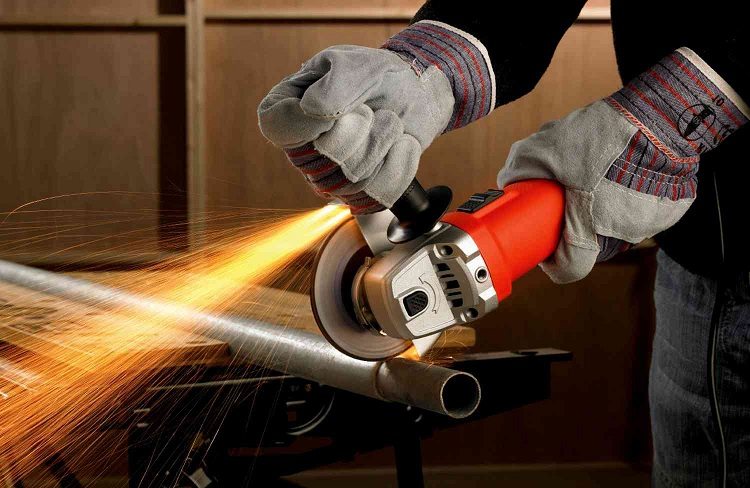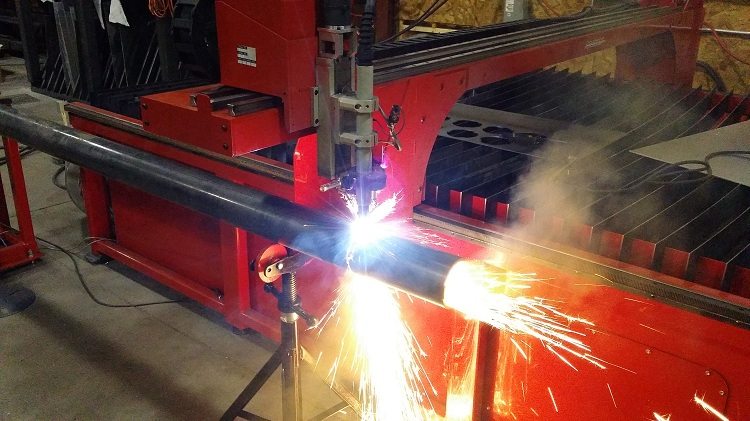The installation of pipelines for various purposes is accompanied by the fitting of materials, which provides for the need to cut pipes to the desired size. If you have to do this often, homeowners usually refuse the services of professionals. Do-it-yourself cutting of steel pipes will allow them to save a considerable amount of money on the work that can be done independently. Moreover, methods have been developed in sufficient quantities today.
Content
Mechanized methods
To simplify the cutting of tubular products, thermal effects on metal and mechanized methods are widely used.
Bulgarian. The use of an angle grinder with an abrasive disk is the most affordable of mechanized methods. It is used not only in everyday life, but also in industry. However, working with a grinder requires the performer to be extremely careful and attentive. After all, a slight skew can cause jamming of the disk and even its destruction. Therefore, do not neglect personal protective equipment. And, of course, you must adhere to the following rules:
- to perform cutting, using a grinder, should be a contractor who has the skills to work with it, and no one else;
- pipes must be fixed in a vice as reliably as possible;
- cutting concrete, stone or other materials with a disk designed for working with metal is prohibited;
- in order to prevent an uncontrolled exit of the disk from the slot, the direction of movement of the angle grinder should be the same as the direction of rotation of the abrasive disk itself;
- before starting work, it is mandatory to wear a protective mask or glasses;
- work with a grinder not equipped with a protective cover is strictly prohibited.
Using a grinder, it is also possible to cut a thick-walled pipe in size. However, at the same time there will be a significant consumption of abrasive discs.
Roller pipe cutter. Here, one or more rollers act as the main working components. Moving along the surface of the pipe, they remove the metal in the cutting zone. Cutting rollers move along the guide of a special holder, which is installed in place of the cut before starting work. The force of their clamping to the pipe is regulated by screw mechanical devices. Cutting is performed by swinging up / down in combination with gradual pressing of the rollers.
It is worth noting the fact that cutting steel pipes of large diameter using a roller pipe cutter does not significantly simplify or accelerate the process.
Thermal cutting methods for metal
The advantage of thermal cutting compared to mechanical is, above all, in higher productivity, as well as in very low energy consumption.
1. Gas pipe cutting. Most often, large-diameter pipes are cut, just like sheet metal, using various types of gas cutters.
Good to know! During the combustion of oxygen-enriched fuels (they may be vapors of kerosene, acetylene, propane), the metal melts and is removed from the cutting site by blowing with a gas stream.
In addition to the above advantages, the low cost of work can also be attributed to the advantages of such a technology.
If highways are laid from pipes of large diameter, the use of manual equipment is impractical. Therefore, in this case, mechanized aggregates are used, which can be equipped with several cutting heads. Such a technical solution contributes to obtaining a precision cut with a simultaneous increase in the speed of execution of the procedure in question. In addition, the edge of the pipe during manual cutting is not formed even and smooth. The use of a semi-automatic machine provides an opportunity to immediately get a high quality result.
2. Plasma cutting of pipes. This technology is also one of the methods of thermal cutting. The temperature that allows melt the metal is produced by a stream of matter in the plasma state. Plasma-forming substance is ordinary air. It acquires a high temperature as a result of ionization, which occurs during the continuous action of an electric discharge.
It is possible to cut pipes using plasma in manual mode, as well as using semi-automatic (or automatic) installations. The latter option is preferable, since a higher cut quality is obtained.
3. Cutting with laser machines. Such units are classified as modern automated systems. Their difference is a wide range of tasks solved in one operation. These include drilling, cutting, milling, edge processing.
Using laser machines, you can process pipes with the following parameters:
- maximum wall thickness: aluminum - 4 mm; stainless steel - 5 mm; black steel - 6.4 mm;
- maximum length - 6.5 meters;
- outer diameter (maximum) - 150 mm.
Profile pipe cutting
The above methods are also suitable for working with profile pipes. But there is one caveat regarding their cutting at an angle of 45 °. If you do the markup manually, errors can occur due to which during the assembly of the pipeline its elements simply will not dock. To eliminate this problem, professionals recommend making a template of the same profile, but with a larger cross section.
To make such a template is not difficult at all:
- Using a protractor, measure an angle of 45 ° on a small segment of the pipe.
- Using a machine with a grinder, make a cut, then grind the edges of the workpiece.
- Then insert a profile pipe with a smaller diameter of the circumscribed circle into the finished template.
- Focusing on the do-it-yourself goniometer, make markings using the scriber.
- On it and make a cut using a grinder.
- At the final stage, sand the edges.
Advice! Do it very carefully. Otherwise, you may be injured by burrs.
How are plastic pipes cut?
The simplest tool that can be used if it becomes necessary to cut a metal-plastic pipe are plumbing scissors. But not any. It should be purchased only the sample that is focused on working specifically with metal-plastic products.
The process carried out with the help of this tool is well controlled visually and does not require excessive efforts. But here one more device is required - a pipe bender. With its help, the pipe will need to be bent, and the cutting itself should be done at the bend.
The simplest models of plumbing scissors are designed to work with pipes with a diameter of not more than 4 cm. But on sale, of course, there are samples with which you can cut products with a large cross section. The advantage of this type of tool is:
- completely waste-free technology. That is, no crumbs remain, therefore, immediately after the cutting operation, you can proceed directly to the assembly of the pipeline;
- Any citizen who does not have professional skills can work with scissors.
Some experienced home craftsmen use a grinder for cutting plastic pipes. In this regard, it is worth listening to their advice. First, you must use a disk designed for cutting metal products. And secondly, you should not make significant efforts when working.
Cutting of purely plastic pipes not reinforced with a reinforcing layer is carried out using the following tools:
- self-sharpening knife. On its blade there are small teeth;
- hacksaw for metal.
The use of these devices leads to the formation of burrs at the ends of the pipes, which will need to be eliminated. And in general, home craftsmen do not recommend cutting plastic pipes with this tool;
- guillotine pipe cutter;
- cordless pipe cutter;
- pipe type cutter;
- scissors for cutting plastic pipes.
And one more important point. For fitting, welding and other types of joints, it is necessary that the cut angle be exactly 90 точно.










